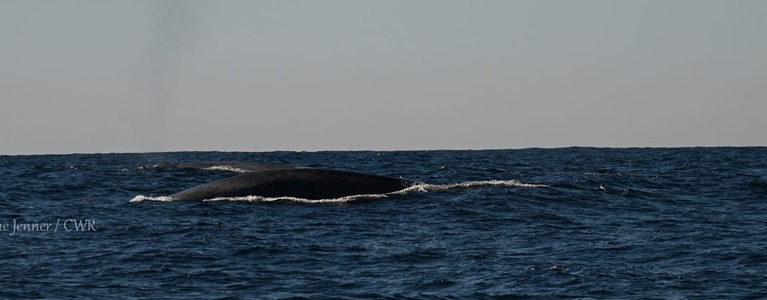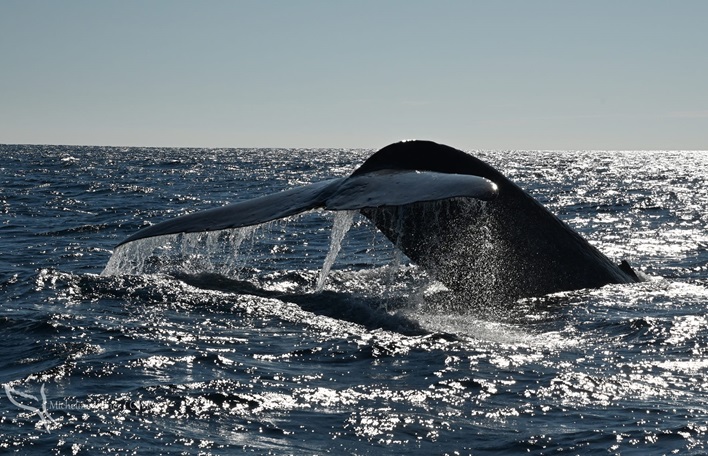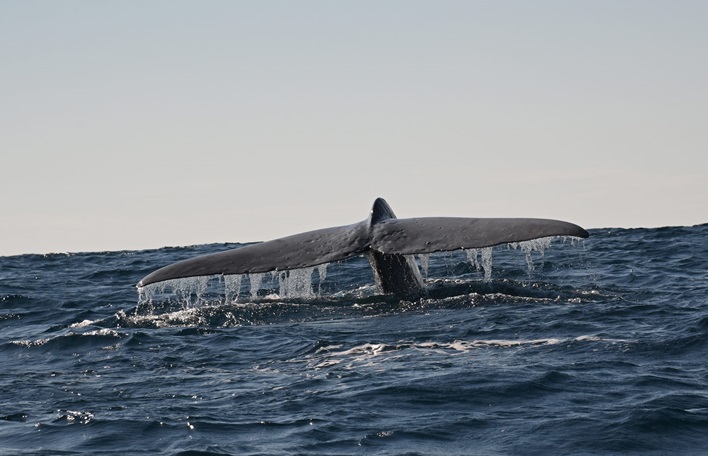
Case Study: Underwater Noise and Whales
Case Study -Underwater Noise and Whales
Sound is a critical sensory cue for many marine animals, including whales and increasing levels of anthropogenic noise in the world’s oceans is a known stressor to marine life. Marine animals such as whales use sound to communicate, navigate and detect predators and prey.
Woodside continues to focus on managing our underwater noise emissions to minimise any impacts to marine mammals in areas in which we operate. Over the last year we have continued to harness emerging and innovative technology to improve our knowledge and understanding of whales (their timing, movement and behaviour), explore novel whale detection methods, and engage large project-based offshore workforces in awareness and marine fauna observer programs with visual whale sightings used to support the implementation of whale management mitigation strategies.
Technology to detect and track whales
With rapid technological and data processing advances, technology and innovation is an important component of Woodside’s science programs and partnerships to understand and manage underwater noise and potential impacts to marine mammals. Activities in 2024 included support for industry collaborative projects and knowledge sharing via the Australian Energy Producer (AEP) and IOGP Joint Industry Programme on Sound and Marine Life
©CWR Centre for Whale Research images - MICHELINE JENNER (CWR)
Distributed acoustic sensing (DAS) applied to whale detection– a proof of concept case study for the North West Shelf, Western Australia
Distributed acoustic sensing (DAS), a type of distributed fibre optic sensing, is a technique for taking spatially resolved strain-rate measurements from discrete points along a fibre-optic cable in real time. Several recently published case studies have demonstrated the effectiveness of deploying DAS along un-lit fibre-optic telecommunications infrastructure (referred to as “dark fibres”) for environmental monitoring of baleen whale vocalisations.
In collaboration with Curtin University via the Woodside FutureLab program, Woodside completed a proof-of-concept trial in 2024 to verify the suitability of repurposing seabed fibre-optic cables for DAS – in this instance, using a section of pre-existing subsea infrastructure that supports production facilities on the North West Shelf (NWS). The trial, which Woodside understands to be an industry first for Australia, targeted offshore Western Australian waters where a number of threatened and migratory whale species are known to be present at various times of the year, including the bi-annual migration of pygmy blue whales between Australian and Indonesian waters. DAS data collection took place over a pre-existing seabed cable between two fixed offshore platforms on the NWS, situated roughly 50 km apart. The trial proved successful, with detection, localisation and tracking of two baleen whale species, the pygmy blue whale and Omura’s whale, over the trial period (late November 2023 to early January 2024). The trial confirmed that seabed DAS using pre-existing infrastructure offers a promising additional technology for the detection and long-term monitoring of whales that is low-cost, effective, and has future potential for automated and near- or real-time data access to inform our environmental management and mitigation actions. Furthermore, the trial indicated the potential for the same data to be used for additional purposes, including the monitoring of offshore geologically sequestered carbon. The project publication outcomes at the end of 2024 include: five extended abstracts, seven conference or workshop presentations, and one pending journal publication. Based on the 2024 outcomes, Woodside will assess undertaking further research to support DAS-based whale detection systems.
Advanced seabed acoustic receivers
Deepwater, multi-directional acoustic receivers, in partnership with JASCO Applied Sciences, were deployed on the seabed at Scott Reef and near Ningaloo Reef in 2023 to allow for continuous passive acoustic monitoring (PAM) of whale vocalisations. This is part of ongoing baseline studies by the Browse Joint Venture partners to understand and confirm whale species presence, timing and movement within and in proximity to the Scott Reef remote reef system to inform facility design and construction planning. In 2024, we continued the PAM program at Scott Reef and expanded the whale detection program to incorporate technology for detecting and measuring the presence of krill and other zooplankton. The aim is to understand the presence and behaviour of pygmy blue whales with prey availability within the Scott Reef possible foraging Biologically Important Area (BIA). Specialised echo sounders were deployed and will monitor continuously for the next year. Vessel based surveys using the same technology, were carried out in 2024 to supplement the seabed and mid-water column ecological monitoring as part of the program design.
Passive acoustic monitoring at Scott Reef – Deployment of an Acoustic Monitoring Lander at Scott Reef. The lander will listen for the sounds of whales for the next six months before being collected and the data analysed to improve our understanding of who is visiting the region. Image credit: Aaron McDonald
Drone deployment of satellite tags
Improving the attachment methods for the whale satellite tag deployment is an area of interest and improvement identified by our research partners. Utilising technology to provide safer, less intrusive and longer tag deployment duration is being addressed via a research and development project supported by Woodside. The Centre for Whale Research (CWR) are exploring the feasibility of a drone tag deployment method. CWR have designed several satellite tag holders (3D printed) and a support frame attachment to conduct drone trials with dummy tags. The plan is to have a tested system in place to support field-based Cat-tag and D-tag deployment on pygmy blue whales in 2025.
High-resolution biologging tags to unlock knowledge on whale vocalisations, environmental context and behaviours
Linking the knowledge and environmental context of pygmy blue whale movement, behaviours and vocalisations is an area of research that is being pursued by a PhD candidate at the Centre for Marine Science and Technology, Curtin University. Woodside recognised the value of this research for understanding the context of vocalisations recorded using passive acoustic monitoring (PAM) and have provided funding support for high resolution biologging tags to be deployed on pygmy blue whales feeding with in the marine environment of the Perth Canyon in 2025.
Satellite tags for whale tracking
We continue to improve the understanding of the movement and behaviour of pygmy blue whales through the offshore waters of northwest Australia utilising satellite tags through the partnership program with the Australian Institute of Marine Science (AIMS) and the Centre for Whale Research (CWR).
A total of 13 new pygmy blue whale tagging tracks were recorded over 2021-2023 adding to the 31 previously recorded satellite tag tracks. To track the movement and behaviour of pygmy blue whales migrating through the offshore waters of Western Australia two types of satellite tags were used. The fastloc GPS tag tracked the long distance migratory journeys and pathways of northbound whales. The pop-up satellite archival tags (PSATs), equipped with accelerometers, provided 3D dive profiles from which migratory swimming, exploratory dives, foraging and lunge feeding behaviours were identified. Combining both data streams allowed for the tracking of the horizontal and vertical movement behaviour in space and time.
All tagging was conducted with the relevant animal ethics permitting and no whale was injured as a result of the tags.



.jpeg?sfvrsn=4f86a5ab_1)